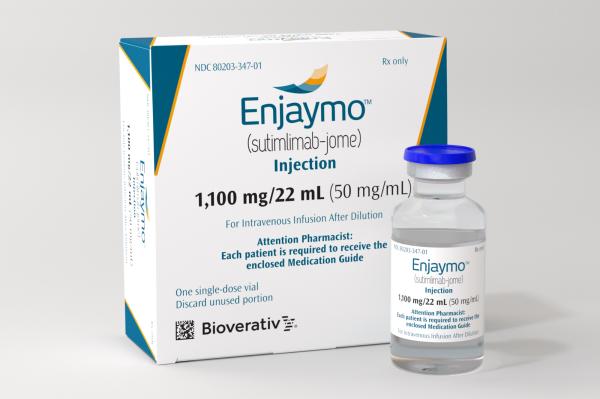Enjaymo Side Effects
Generic name: sutimlimab
Medically reviewed by Drugs.com. Last updated on Nov 4, 2023.
Note: This document contains side effect information about sutimlimab. Some dosage forms listed on this page may not apply to the brand name Enjaymo.
Applies to sutimlimab: intravenous solution.
Serious side effects of Enjaymo
Along with its needed effects, sutimlimab (the active ingredient contained in Enjaymo) may cause some unwanted effects. Although not all of these side effects may occur, if they do occur they may need medical attention.
Check with your doctor or nurse immediately if any of the following side effects occur while taking sutimlimab:
More common
- Bladder pain
- bloody or cloudy urine
- bluish color of the fingernails, lips, skin, palms, or nail beds
- blurred vision
- chest pain
- chills
- cough
- diarrhea
- difficult, burning, or painful urination
- dizziness
- ear congestion or pain
- fever
- frequent urge to urinate
- head congestion
- hoarseness or other voice changes
- loss of appetite
- lower back or side pain
- muscle aches
- nausea
- nervousness
- pounding in the ears
- slow or fast heartbeat
- stomach pain
- stuffy or runny nose
- sneezing
- sore throat
- swelling of the hands, ankles, feet, or lower legs
- weakness
Incidence not known
- Back pain
- blisters or itching
- dark urine
- decreased urination
- general feeling of discomfort or illness
- hair loss
- skin rash
- swollen glands
- tiredness
- yellow eyes or skin
Other side effects of Enjaymo
Some side effects of sutimlimab may occur that usually do not need medical attention. These side effects may go away during treatment as your body adjusts to the medicine. Also, your health care professional may be able to tell you about ways to prevent or reduce some of these side effects.
Check with your health care professional if any of the following side effects continue or are bothersome or if you have any questions about them:
More common
- Acid or sour stomach
- belching
- difficulty in moving
- heartburn
- indigestion
- muscle pain or stiffness
- pain, swelling, or redness in the joints
- stomach discomfort, upset, or pain
For Healthcare Professionals
Applies to sutimlimab: intravenous solution.
General
The most common adverse reactions in 1 study were rhinitis, headache, hypertension, acrocyanosis, and Raynaud's phenomenon. The most common adverse reactions in another study were urinary tract infection, respiratory tract infection, bacterial infection, dizziness, fatigue, peripheral edema, arthralgia, cough, hypertension, and nausea.[Ref]
Cardiovascular
Hypertension included increased blood pressure and essential hypertension.
Very common (10% or more): Hypertension (up to 25%), acrocyanosis (up to 21%), Raynaud's phenomenon (up to 18%)
Dermatologic
Frequency not reported: Skin infections, pruritus
Gastrointestinal
Abdominal pain included upper abdominal pain and abdominal tenderness.
Very common (10% or more): Nausea (up to 25%), abdominal pain (up to 21%)
Frequency not reported: Upper abdominal pain
Genitourinary
Very common (10% or more): Urinary tract infection (up to 38%)
Frequency not reported: Urinary tract infection with sepsis, bacterial urinary tract infection, urosepsis
Urinary tract infection included cystitis and urosepsis.
Immunologic
Very common (10% or more): Antidrug antibodies (up to 12%)
Common (1% to 10%): Relapse/worsening of autoimmune disease
Musculoskeletal
Very common (10% or more): Arthralgia (up to 25%)
Nervous system
Dizziness included postural dizziness and vertigo.
Very common (10% or more): Dizziness (up to 29%), headache (up to 23%)
Other
Fatigue included asthenia, malaise, and mental fatigue.
Infusion-related reactions (e.g., shortness of breath, rapid heartbeat, nausea, flushing, headache, hypotension, chest discomfort, pruritus, rash, injection-site reaction, and dizziness) were reported in 29% of patients from 2 clinical trials. In 1 clinical trial, infusion-related reaction included stress cardiomyopathy and feeling cold; all occurred within 24 hours of the start of the infusion.
Bacterial infection included Escherichia urinary tract infection, bacterial urinary tract infection, bacterial cystitis, Escherichia sepsis, pneumococcal sepsis, Klebsiella pneumonia, streptococcal sepsis, and staphylococcal wound infection.
Peripheral edema included peripheral swelling.
Viral infection included oral herpes, herpes zoster, viral respiratory tract infection, viral upper respiratory tract infection, and Herpes simplex viremia.
Very common (10% or more): Fatigue (up to 33%), infusion-related reactions (up to 29%), bacterial infection (up to 25%), peripheral edema (up to 25%), viral infection (up to 21%), pyrexia (up to 21%), serious bacterial and viral infections (up to 15%)
Frequency not reported: Sepsis with urinary tract infection, otomastoiditis, febrile infection, chest discomfort, viral infection
Renal
Frequency not reported: Increased blood creatinine
Respiratory
Very common (10% or more): Respiratory tract infection (up to 25%), cough (up to 25%), nasopharyngitis (up to 21%), rhinitis (up to 18%)
Frequency not reported: Pneumonia, Klebsiella pneumonia, coronavirus disease 2019 (COVID-19) pneumonia
Respiratory tract infection included upper respiratory tract infection, bronchitis, lower respiratory tract infection, and COVID-19 pneumonia.
Cough included productive cough.
More about Enjaymo (sutimlimab)
- Check interactions
- Compare alternatives
- Pricing & coupons
- Drug images
- Dosage information
- During pregnancy
- FDA approval history
- Drug class: selective immunosuppressants
- Breastfeeding
- En español
Patient resources
Professional resources
Related treatment guides
References
1. Product Information. Enjaymo (sutimlimab). Bioverativ Therapeutics Inc. 2023;SUPPL-3.
Further information
Always consult your healthcare provider to ensure the information displayed on this page applies to your personal circumstances.
Some side effects may not be reported. You may report them to the FDA.

